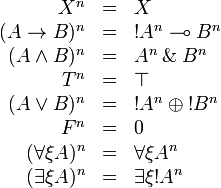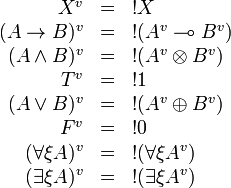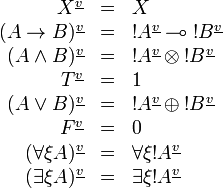Translations of intuitionistic logic
(Definitions of three translations) |
m (→Call-by-name Girard's translation A\imp B \mapsto \oc{A}\limp B: use of \rulename) |
||
| Line 25: | Line 25: | ||
<math> |
<math> |
||
| − | \LabelRule{\textit{ax}} |
+ | \LabelRule{\rulename{ax}} |
\NulRule{A\vdash A} |
\NulRule{A\vdash A} |
||
\DisplayProof |
\DisplayProof |
||
\qquad\mapsto\qquad |
\qquad\mapsto\qquad |
||
| − | \LabelRule{\textit{ax}} |
+ | \LabelRule{\rulename{ax}} |
\NulRule{A^n\vdash A^n} |
\NulRule{A^n\vdash A^n} |
||
\LabelRule{\oc L} |
\LabelRule{\oc L} |
||
| Line 41: | Line 41: | ||
\AxRule{\Gamma\vdash A} |
\AxRule{\Gamma\vdash A} |
||
\AxRule{\Delta,A\vdash B} |
\AxRule{\Delta,A\vdash B} |
||
| − | \LabelRule{\textit{cut}} |
+ | \LabelRule{\rulename{cut}} |
\BinRule{\Gamma,\Delta\vdash B} |
\BinRule{\Gamma,\Delta\vdash B} |
||
\DisplayProof |
\DisplayProof |
||
| Line 49: | Line 49: | ||
\UnaRule{\oc{\Gamma^n}\vdash \oc{A^n}} |
\UnaRule{\oc{\Gamma^n}\vdash \oc{A^n}} |
||
\AxRule{\oc{\Delta^n},\oc{A^n}\vdash B^n} |
\AxRule{\oc{\Delta^n},\oc{A^n}\vdash B^n} |
||
| − | \LabelRule{\textit{cut}} |
+ | \LabelRule{\rulename{cut}} |
\BinRule{\oc{\Gamma^n},\oc{\Delta^n}\vdash B^n} |
\BinRule{\oc{\Gamma^n},\oc{\Delta^n}\vdash B^n} |
||
\DisplayProof |
\DisplayProof |
||
| Line 108: | Line 108: | ||
\LabelRule{\oc R} |
\LabelRule{\oc R} |
||
\UnaRule{\oc{\Gamma^n}\vdash \oc{A^n}} |
\UnaRule{\oc{\Gamma^n}\vdash \oc{A^n}} |
||
| − | \LabelRule{\textit{ax}} |
+ | \LabelRule{\rulename{ax}} |
\NulRule{B^n\vdash B^n} |
\NulRule{B^n\vdash B^n} |
||
\LabelRule{\limp L} |
\LabelRule{\limp L} |
||
| Line 117: | Line 117: | ||
\UnaRule{\oc{\Gamma^n},\oc{(\oc{A^n}\limp B^n)}\vdash \oc{B^n}} |
\UnaRule{\oc{\Gamma^n},\oc{(\oc{A^n}\limp B^n)}\vdash \oc{B^n}} |
||
\AxRule{\oc{\Delta^n},\oc{B^n}\vdash C^n} |
\AxRule{\oc{\Delta^n},\oc{B^n}\vdash C^n} |
||
| − | \LabelRule{\textit{cut}} |
+ | \LabelRule{\rulename{cut}} |
\BinRule{\oc{\Gamma^n},\oc{\Delta^n},\oc{(\oc{A^n}\limp B^n)}\vdash C^n} |
\BinRule{\oc{\Gamma^n},\oc{\Delta^n},\oc{(\oc{A^n}\limp B^n)}\vdash C^n} |
||
\DisplayProof |
\DisplayProof |
||
| Line 146: | Line 146: | ||
\DisplayProof |
\DisplayProof |
||
\qquad\mapsto\qquad |
\qquad\mapsto\qquad |
||
| − | \LabelRule{\textit{ax}} |
+ | \LabelRule{\rulename{ax}} |
\NulRule{A^n\vdash A^n} |
\NulRule{A^n\vdash A^n} |
||
\LabelRule{\with_1 L} |
\LabelRule{\with_1 L} |
||
| Line 155: | Line 155: | ||
\UnaRule{\oc{(A^n\with B^n)}\vdash \oc{A^n}} |
\UnaRule{\oc{(A^n\with B^n)}\vdash \oc{A^n}} |
||
\AxRule{\oc{\Gamma^n},\oc{A^n}\vdash C^n} |
\AxRule{\oc{\Gamma^n},\oc{A^n}\vdash C^n} |
||
| − | \LabelRule{\textit{cut}} |
+ | \LabelRule{\rulename{cut}} |
\BinRule{\oc{\Gamma^n},\oc{(A^n\with B^n)}\vdash C^n} |
\BinRule{\oc{\Gamma^n},\oc{(A^n\with B^n)}\vdash C^n} |
||
\DisplayProof |
\DisplayProof |
||
| Line 242: | Line 242: | ||
\DisplayProof |
\DisplayProof |
||
\qquad\mapsto\qquad |
\qquad\mapsto\qquad |
||
| − | \LabelRule{\textit{ax}} |
+ | \LabelRule{\rulename{ax}} |
\NulRule{A^n[\tau^n/\xi]\vdash A^n[\tau^n/\xi]} |
\NulRule{A^n[\tau^n/\xi]\vdash A^n[\tau^n/\xi]} |
||
\LabelRule{\forall L} |
\LabelRule{\forall L} |
||
| Line 251: | Line 251: | ||
\UnaRule{\oc{\forall\xi A^n}\vdash \oc{(A^n[\tau^n/\xi])}} |
\UnaRule{\oc{\forall\xi A^n}\vdash \oc{(A^n[\tau^n/\xi])}} |
||
\AxRule{\oc{\Gamma^n},\oc{(A^n[\tau^n/\xi])}\vdash C^n} |
\AxRule{\oc{\Gamma^n},\oc{(A^n[\tau^n/\xi])}\vdash C^n} |
||
| − | \LabelRule{\textit{cut}} |
+ | \LabelRule{\rulename{cut}} |
\BinRule{\oc{\Gamma^n},\oc{\forall\xi A^n}\vdash C^n} |
\BinRule{\oc{\Gamma^n},\oc{\forall\xi A^n}\vdash C^n} |
||
\DisplayProof |
\DisplayProof |
||
| Line 287: | Line 287: | ||
\DisplayProof |
\DisplayProof |
||
</math> |
</math> |
||
| − | |||
== Call-by-value translation <math>A\imp B \mapsto \oc{(A\limp B)}</math> == |
== Call-by-value translation <math>A\imp B \mapsto \oc{(A\limp B)}</math> == |
||
Revision as of 23:15, 12 February 2009
The genesis of linear logic comes with a decomposition of the intuitionistic implication. Once linear logic properly defined, it corresponds to a translation of intuitionistic logic into linear logic, often called Girard's translation. In fact Jean-Yves Girard has defined two translations in his linear logic paper[1]. We call them the call-by-name translation and the call-by-value translation.
These translations can be extended to translations of classical logic into linear logic.
Contents |
Call-by-name Girard's translation 
Formulas are translated as:

This is extended to sequents by  .
.
This allows one to translate the rules of intuitionistic logic into linear logic:













![\AxRule{\Gamma,A[\tau/\xi]\vdash C}
\LabelRule{\forall L}
\UnaRule{\Gamma,\forall\xi A\vdash C}
\DisplayProof
\qquad\mapsto\qquad
\LabelRule{\rulename{ax}}
\NulRule{A^n[\tau^n/\xi]\vdash A^n[\tau^n/\xi]}
\LabelRule{\forall L}
\UnaRule{\forall\xi A^n\vdash A^n[\tau^n/\xi]}
\LabelRule{\oc d L}
\UnaRule{\oc{\forall\xi A^n}\vdash A^n[\tau^n/\xi]}
\LabelRule{\oc R}
\UnaRule{\oc{\forall\xi A^n}\vdash \oc{(A^n[\tau^n/\xi])}}
\AxRule{\oc{\Gamma^n},\oc{(A^n[\tau^n/\xi])}\vdash C^n}
\LabelRule{\rulename{cut}}
\BinRule{\oc{\Gamma^n},\oc{\forall\xi A^n}\vdash C^n}
\DisplayProof](/mediawiki/images/math/d/5/c/d5cee7e0d3193ed8f5cfe81c35383ad8.png)
![\AxRule{\Gamma\vdash A[\tau/\xi]}
\LabelRule{\exists R}
\UnaRule{\Gamma\vdash \exists\xi A}
\DisplayProof
\qquad\mapsto\qquad
\AxRule{\oc{\Gamma^n}\vdash A^n[\tau^n/\xi]}
\LabelRule{\oc R}
\UnaRule{\oc{\Gamma^n}\vdash \oc{(A^n[\tau^n/\xi])}}
\LabelRule{\exists R}
\UnaRule{\oc{\Gamma^n}\vdash \exists\xi\oc{A^n}}
\DisplayProof](/mediawiki/images/math/1/a/f/1af8899204390f21703fe4649ca8ff4b.png)

Call-by-value translation 
Formulas are translated as:

The translation of any formula starts with  , we define
, we define  such that
such that  .
.
The translation of sequents is  .
.
This allows one to translate the rules of intuitionistic logic into linear logic:













We use ![(A[\tau/\xi])^v=A^v[\tau^{\underline{v}}/\xi]](/mediawiki/images/math/a/9/d/a9d5b23683d35f64287bdbea06658fbe.png) .
.
![\AxRule{\Gamma,A[\tau/\xi]\vdash C}
\LabelRule{\forall L}
\UnaRule{\Gamma,\forall\xi A\vdash C}
\DisplayProof
\qquad\mapsto\qquad
\AxRule{\Gamma^v,A^v[\tau^{\underline{v}}/\xi]\vdash C^v}
\LabelRule{\forall L}
\UnaRule{\Gamma^v,\forall\xi A^v\vdash C^v}
\LabelRule{\oc L}
\UnaRule{\Gamma^v,\oc{(\forall\xi A^v)}\vdash C^v}
\DisplayProof](/mediawiki/images/math/0/7/a/07a778b4b3ef297931dfa14975b7aaaf.png)
![\AxRule{\Gamma\vdash A[\tau/\xi]}
\LabelRule{\exists R}
\UnaRule{\Gamma\vdash \exists\xi A}
\DisplayProof
\qquad\mapsto\qquad
\AxRule{\Gamma^v\vdash A^v[\tau^{\underline{v}}/\xi]}
\LabelRule{\exists R}
\UnaRule{\Gamma^v\vdash \exists\xi A^v}
\LabelRule{\oc R}
\UnaRule{\Gamma^v\vdash \oc{\exists\xi A^v}}
\DisplayProof](/mediawiki/images/math/9/9/b/99b9160fe495dd287fe79cde394069c2.png)

Alternative presentation
It is also possible to define  as the primitive construction.
as the primitive construction.

If we define  , we have
, we have  and thus we obtain the same translation of proofs.
and thus we obtain the same translation of proofs.
Call-by-value Girard's translation 
The original version of the call-by-value translation given by Jean-Yves Girard[1] is an optimisation of the previous one using properties of positive formulas.
Formulas are translated as:

The translation of any formula is a positive formula.
The translation of sequents is  .
.
This allows one to translate the rules of intuitionistic logic into linear logic:













We use ![(A[\tau/\xi])^w\linequiv A^w[\tau^w/\xi]](/mediawiki/images/math/1/f/e/1fed7f14b8b6a3f49aca3fb9279ea6a1.png) .
.
![\AxRule{\Gamma,A[\tau/\xi]\vdash C}
\LabelRule{\forall L}
\UnaRule{\Gamma,\forall\xi A\vdash C}
\DisplayProof
\qquad\mapsto\qquad
\AxRule{\Gamma^w,(A[\tau/\xi])^w\vdash C^w}
\UnaRule{\Gamma^w,A^w[\tau^w/\xi]\vdash C^w}
\LabelRule{\forall L}
\UnaRule{\Gamma^w,\forall\xi A^w\vdash C^w}
\LabelRule{\oc L}
\UnaRule{\Gamma^w,\oc{(\forall\xi A^w)}\vdash C^w}
\DisplayProof](/mediawiki/images/math/c/5/4/c5462eb831a416afaeb71dc7005f3d0e.png)
![\AxRule{\Gamma\vdash A[\tau/\xi]}
\LabelRule{\exists R}
\UnaRule{\Gamma\vdash \exists\xi A}
\DisplayProof
\qquad\mapsto\qquad
\AxRule{\Gamma^w\vdash (A[\tau/\xi])^w}
\UnaRule{\Gamma^w\vdash A^w[\tau^w/\xi]}
\LabelRule{\exists R}
\UnaRule{\Gamma^w\vdash \exists\xi A^w}
\DisplayProof](/mediawiki/images/math/e/f/c/efc024440beb68a1b97abf848815394e.png)

References
- ↑ 1.0 1.1 Girard, Jean-Yves. Linear logic. Theoretical Computer Science. Volume 50, Issue 1, pp. 1-101, doi:10.1016/0304-3975(87)90045-4, 1987.